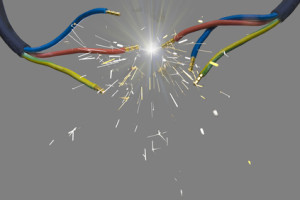As complicated as electrical systems are, the problems you encounter at home usually have simple explanations. With a few safety precautions — be sure to turn off power before digging into things, and wear electrical gloves when working in the panel — you can quickly identify whether you can resolve your own electrical problems and what to tell your electrician.
This little guide should help you correct many simple electrical problems. Just be ready to call us to replace wiring or alter the electrical panel.

Rule Out Human Error
Perhaps you became flustered when the electrical problems began. Take a deep breath and check all the basics to rule out simple errors:
- Power strips/surge protectors are switched on.
- GFCI has been reset, if applicable.
- Tripped circuit breaker has been switched back on or blown fuse replaced.
- Appliance isn’t to blame — something else works when plugged into the same outlet.
- Light bulb isn’t burnt out — a wrong-sized bulb may have burnt out quickly.
Check the Electrical Panel
If your home has power in other areas, or your neighbors haven’t lost power, you need to check the breaker panel or fuse box for electrical problems.
Give breaker switches a good push to the off position before firmly switching them back on. Also check whether the main breaker was tripped. If so, you could have serious electrical problems — be cautious and don’t turn everything back on at once. Unplug major appliances, computers, and expensive electronics before trying to restore power.
Troubleshooting a Dead Outlet
Electrical outlets cost little to replace, and it’s a fast service call for a professional electrician. Before going that route, you want to look for other electrical problems like bad wiring, though.
- Test other outlets in the room. If they’re all dead, you more likely have a wiring or circuit problem.
- Reset any GFCI breaker nearby. If the GFCI is earlier in the circuit, it shuts off other outlets down the line. You may also have a GFCI breaker inside the panel.
- Remove the outlet cover to look for loose connections, frayed wires, or signs of melting or burning.
- Replace the outlet or call a local electrician to do so. Tighten or replace connections that appear to have recently gone loose. If any signs of overheating or burn damage are present, replace the whole thing.
Other Electrical Problems to Look For
Whether you are well-versed in electrical systems or not, you can probably spot whether something is wrong. Try to find things like frayed wires, broken wire nuts, burn damage, or various issues like rodent bite marks on wiring.
Note: electrical panels have live wires, and electrocution or death is very possible. If you find yourself going down a rabbit hole of troubleshooting, use insulated gloves and mark live wires with colored, insulated tape.
Some examples of other electrical problems to look for:
- Panel has a large number of tandem breakers and/or double-pole breakers
- Breaker switches look like they were added at different times — one or more may be mis-sized
- Aluminum wiring or ceramic knob-and-tube wiring
- Bad wiring at the weatherhead where power lines enter your home (causes flickering lights in bad weather)
When in Doubt, Leave Electrical Problems to the Pros
Troubleshooting means finding a problem — not fixing it. Only if you are very comfortable with wiring and knowledgeable about safety should you try to do much more than replace a light switch.
Shut off power, look for a problem, and then contact us your local electrician as soon as you need help.

